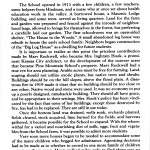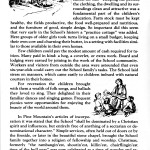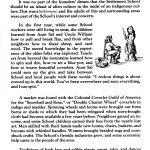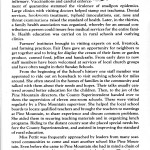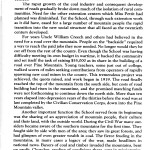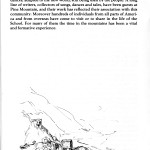Pine Mountain Settlement School
Series 04: Pine Mountain Settlement School Histories
THE PINE MOUNTAIN STORY – CH. II
TAGS: The Pine Mountain Story – Ch. II ; Early Years of Pine Mountain Settlement School 1913-1930 ; Mary Rogers ; Mary Rockwell Hook ; fundraising ; folk songs and dance ; PMSS articles of incorporation ; chapel ; Nativity Play ; community interaction ; Katherine Pettit ; health services ; supervision of one-room schools ; extension centers ; growth of coal industry ; increased road-building ; outsiders’ appreciation of mountain people, land and culture ; portrayals of “mountaineer” in literature ;
THE PINE MOUNTAIN STORY – CH. II contains the images and transcription of Chapter II of “The Pine Mountain Story 1913-1980.” This chapter describes: “The Early Years of Pine Mountain Settlement School 1913 – 1930.”
The booklet was written and illustrated in 1980 by Mary Rogers. Mary was a PMSS worker for over 50 years and wife of Burton Rogers, director of the School from 1949 to 1973.
For other chapters and more about “The Pine Mountain Story 1913-1980” and the author, Mary Rogers, go to GUIDE TO “THE PINE MOUNTAIN STORY 1913-1980.”
CONTENTS: The Pine Mountain Story – Ch. II
Early Years of Pine Mountain Settlement School 1913-1930 ; Mary Rogers illustrations ; health education ; nurses ; the first schoolroom ; The House in the Woods ; Big Log House ; Mary Rockwell (Mrs. Inghram Hook) ; architects ; landscaping ; area planning ; disastrous fire ; PMSS farm ; fundraising letters and trips ; boarding schools ; student duties ; Practice Cottage ; tuition payments ; recreation ; folk songs & ballads ; folk dancing ; picnics ; PMSS articles of incorporation ; Christian spirit ; chapel ; Christmas celebrations ; Nativity Play ; high school classes ; Shakespeare plays ; community interaction ; flax ; wool ; dyeing ; weaving ; Colonial Coverlet Guild of America ; coverlets ; regaining lost arts ; fireside industries ; rules against drinking or guns ; Katherine Pettit ; health services ; doctors ; infirmary ; vaccinations ; quarantines ; clinics ; dental services ; physical examinations ; family health association ; visiting farm experts ; Fair Days ; horseback librarian ; supervision of one-room schools ; extension centers ; Line Fork extension ; Medical Settlement at Big Laurel ; growth of coal industry ; increased road-building ; road over mountain ; Civilian Conservation Corps ; outsiders’ appreciation of mountain people, land and culture ; missionaries ; portrayals of “mountaineer” in literature ; Cecil Sharp ; visitors ;
GALLERY: The Pine Mountain Story – Ch. II
- Mary Rogers: The Pine Mountain Story – Ch. II [pmss-story005.jpg]
- Mary Rogers: The Pine Mountain Story – Ch. II [pmss-story006.jpg]
- Mary Rogers: The Pine Mountain Story – Ch. II [pmss-story007.jpg]
- Mary Rogers: The Pine Mountain Story – Ch. II [pmss-story008.jpg]
- Mary Rogers: The Pine Mountain Story – Ch. II [pmss-story009.jpg]
- Mary Rogers: The Pine Mountain Story – Ch. II [pmss-story010.jpg]
TRANSCRIPTION: The Pine Mountain Story – Ch. II
[pmss_story005.jpg]
CHAPTER II
THE EARLY YEARS OF
PINE MOUNTAIN SETTLEMENT SCHOOL 1913-1930
The School opened in 1913 with a few children, a few teachers, some helpers from Hindman, and a nurse who at once set about health education work in the valley. A borrowed house, a Masonic Lodge building, and some tents served as living quarters. Land for the farm and garden was prepared and fenced against the inroads of neighborhood hogs, allowed to forage for themselves in the forest, but preferring a carefully laid out garden. The first schoolroom was an open-sided shelter, “The House in the Woods.” A small abandoned log house was rebuilt to house the early school family. Neighbors began construction of the “Big Log House” as a dwelling for future students.
It is important to realize at this point the priceless contribution made by Mary Rockwell, who became Mrs. Inghram Hook, a prominent Kansas City architect, to the development of the cutover acres that became Pine Mountain School’s property. Mary Rockwell had a true eye for area planning. Arable acres must be free for farming. Landscaping should not utilize exotic plants, but native trees and shrubs. Buildings should be on the hill slopes, above the flood plain. A disastrous fire in 1919 made it clear that no building should be too close to any other. Native wood and stone were used. It was no economy to put up a poorly designed, ramshackle building. They should all have grace, and be appropriate to their settings. Mrs. Hook’s policy has been vindicated by the fact that none of her buildings, except those destroyed by fire, has had to be replaced. They are still in use today.
Once the bottom land was drained, wells sunk, orchards planted, fields cleared, stock acquired, lime burned for the fields, and harvests gathered, it became possible for the School to expand. With the wherewithal for a varied and nourishing diet of milk, eggs, fruit and vegetables from the School farm, it was possible to admit more students.
Very soon more houses began to be needed to accommodate some of the many children who begged for admittance. Agonizing decisions had to be made as to whether to crowd in one more family of children or to turn them away. Many walked miles only to find there was no room for them. Again and again, just as the bank account was empty, an unexpected gift would enable the School to carry on. Letters went out regularly to a widening circle of friends, and friends of friends, describing the opportunities and the needs. These letters provide today a vivid picture of the School’s early days. Staff members, busy with the countless jobs facing them, had to make time for fund-raising trips.
5
[pmss_story006.jpg]
[Illustration: Small ink sketch by Mary Rogers depicting Big Log.]
Of necessity Pine Mountain was a boarding school, not only because there were no roads, but because the School needed to have the children in residence in order to give them, along with “book larnin’,” an “education for life.” Keeping the person, the clothing, the dwelling and its surroundings clean and attractive was a fundamental part of the children’s education. Farm stock must be kept healthy, the fields productive, the food well-prepared and nutritious, and the furniture of good, simple design. So important did this seem that very early in the School’s history a “practice cottage” was added. Here groups of older girls took turns living on a small budget, keeping their own cow and churning their butter, in a setting with facilities similar to those available in their own homes.
Few children could pay the modest amount of cash required for tuition. Many paid in kind: a hog, a coverlet, or extra work. Board and lodging were earned by joining in the work of the School community. Workers and visitors from outside the area were astounded that even six-year-olds could carry out the School family’s tasks. The School laid stress on manners, which came easily to children imbued with natural courtesy in their homes.
[Illustration: Small sketch by Mary Rogers of woman playing dulcimer to children seated around her.]
For recreation the children brought with them a wealth of folk songs, and ballads they loved to sing. They delighted in their familiar dances and singing games. Frequent picnics were opportunities for enjoying the beauty of the world around them.
In Pine Mountain’s articles of incorporation it was stated that the School “shall be dominated by a Christian spirit and influences, but entirely free of anything of a sectarian or denominational character.” Simple services, often held out of doors or by the fireside, or later in the beautiful stone chapel, brought the School family together into a religion of fellowship and worship. Christmas, formerly “the rambangin’est, shootin’est, killin’est, chairflingin’est time of the hull year” was now celebrated as a time of wonder and rejoicing. The climax of the season was a presentation of the Christmas story in a simple and moving Nativity Play. Religion, never an exclusively Sunday thing, was the mainspring of the energy which activated every School undertaking.
The lower grades accepted not only small children but also sixteen and eighteen-year-olds who had never had an opportunity to attend…
6
[pmss_story007.jpg]
…school. As soon as several students had completed the eighth grade, high school classes were added. The old world inheritance of the mountain people, cultivated by the School, led to performances of Julius Caesar, Hamlet, Midsummer Night’s Dream, staged in some outdoor setting on the School grounds.
It was no part of the founders’ dream that the Settlement School should be an island of alien culture in the midst of an indigenous culture. This was a Settlement, and the adults of this and surrounding areas were part of the School’s interest and concern.
[Illustration; Ink sketch by Mary Rogers of two girls working at household tasks.]
In the first year, while some School workers were still living in tents, the children learned from Aunt Sal and Uncle William [Creech] how to pull and break flax, and from other neighbors how to shear sheep, and card wool. The stored knowledge in the experience of the older folks was explored. Teachers from beyond the mountains learned how to spin and dye, how to set a blue pot, and how to weave beautiful coverlets. Aunt Sal could sum up the give and take between School and local people with these words: “I reckon things is about evened up in this world. You’ve been everywhere and seen everything, and I can spin.”
A market was found with the Colonial Coverlet Guild of America for the “Snowball and Rose,” or “Double Chariot Wheel” coverlets in indigo and madder. Spinning wheels and looms were brought out from barns or sheds to which they had been relegated when store-bought cloth had become available a few years before. Neighbors gained an income, and some School children earned their fees from the nearly lost art. Men skilled with their hands made new looms, chairs, baskets, and brooms with whittled handles. Women brought braided rugs and cornshuck crafts. The School’s fireside industries grew, and some economic help came to the people of the area.
Traditions of herb lore and edible plants, songs, tales, and dances were gathered and enjoyed at the School. The only stipulation about the dances was that there should be no drinking, and guns must be handed over to Miss [Katherine] Pettit while the parties were in progress. She was quick to understand that the drinking and shooting which bedeviled so many neighborhood meetings, and sometimes led to killings, were no part of the genuine recreation afforded by the dance.
7
[pmss_story008.jpg]
[Illustration: Ink sketch by Mary Rogers of four men carrying a stretcher on their shoulders.]
Health services were first provided by a nurse, then by a doctor, and soon an infirmary was built. For decades Pine Mountain provided the only medical services for an area of over three hundred square miles. Many of the present day population were born in the infirmary. Vaccinations and careful enforcement of quarantine stemmed the virulence of smallpox epidemics. Large clinics with visiting doctors helped stamp out trachoma. Dental services, hookworm treatment, typhoid inoculations, ear, nose and throat examinations raised the standard of health. Later, in the thirties, a family health association was organized, whereby for an annual contribution a person could ensure free medical services for the entire family. Health education was carried on in rural schools and outlying clinics.
Farmers’ institutes brought in visiting experts on soil, livestock, and farming practices. Fair Days gave an opportunity for neighbors to get together and to bring for display the cream of their farm or garden produce, canned food, jellies and handcrafts. From early days to now staff members have been welcomed at services of local church groups and have often taught in their Sunday Schools.
From the beginning of the School’s history one staff member was appointed to ride out on horseback to visit outlying schools for miles around. She often stayed in the homes of families in the community and talked with them about their needs and hopes. Their talks usually centered around better education for the children. Then, to the joy of the Pine Mountain directors, the County Superintendent handed over to them the supervision of eleven one-room schools. These were visited regularly by a Pine Mountain supervisor. She helped the local school boards to locate qualified teachers and brought the teachers to meetings at Pine Mountain, to share experience and discuss common problems. She aided them in securing teaching materials and in organizing lunch programs. Riding to the distant county seat she placed special needs before the County Superintendent, and assisted in improving the standard of rural education.
Miss Pettit was frequently approached by leaders from many scattered communities to come and start another school like Pine Mountain. Even before she came to Pine Mountain she had in mind a chain of extension centers reaching out to the most isolated areas. These hopes led to a firm intention of setting up five centers in ten years. The rural school supervisor, already known in outlying areas through her work with the schools, was appointed to head up this work, too.
Two centers were soon established. Interest in a sewing class led to friendship and mutual trust. When the neighborhood expressed a desire for workers to live in their community, and were ready to help provide…
8
[pmss_story009.jpg]
…the house Pine Mountain responded. These workers arranged homemakers’ groups, health clinics, community recreation, and rendered any help they were able to offer. The Line Fork Extension in 1920 was the home of the first trained nurse to work in Letcher County. The Medical Settlement at Big Laurel in 1920 housed the first woman doctor in the area. Ministers, teachers and social workers also served at the centers.
The rapid growth of the coal industry and consequent development of roads gradually broke down much of the isolation of rural communities. Need for the other extension centers which Miss Pettit had planned was diminished. Yet the School, through such extension work as it did have, eased for a large number of mountain people the rapid transition into the new social structure that all faced as the twentieth century developed.
For years Uncle William Creech and others had believed in the need for a road over the mountain. People on the “backside” required a way to reach the paid jobs they now needed. No longer would they be cut off from the rest of the county. Even though the School was having difficulty meeting its own budget in wartime, it backed the community and set itself the task of raising $55,000 as its share in the building of a road over Pine Mountain. Young teachers, some just out of college, walked scores of miles seeking contributions from operators of rapidly spawning new coal mines in the county. This tremendous project was achieved, the quota raised, and work began in 1919. The road finally reached the top of the mountain from the south side, but costs of road building had risen in the meantime, and the promised matching funds were not forthcoming to continue down the north side. More than ten years elapsed into depression years of the thirties before the road was at last completed by the Civilian Conservation Corps, down into the Pine Mountain valley.
Another important function the School served from its beginning was the sharing of an appreciation of mountain people, their culture and their land, with the outside world. During the Civil War many outsiders became aware of the southern mountains for the first time. They fought side by side with men of the area; they saw its great forests, and had glimpses of even greater wealth in coal. The fierce feuding in the mountains, in many cases a legacy of the war, made headlines in national news. Buyers of coal and timber invaded the mountains, bent on profit. Churches, reading of conditions there, sent in missionaries, and published stories of the area throughout the country, to enlist support for their work. Novelists like John Fox, Jr., writers of articles, plays and poetry, such as Percy McKaye, sociologists such as John C. Campbell, and Cecil Sharp, a British folklorist, all mined the particular lode in mountain life which suited their fields. The picture of the mountains and the “mountaineer” which emerged from this spate of writings…
9
[pmss_story010.jpg]
…ranged from the romantic to the quaint, from the noble to the abject. Stereotypes were being created. The School felt a deep obligation that those who wrote about their friends and neighbors should know them not as types but as individuals.
Cecil Sharp visited the School in 1917. He was excited to find a wealth of folk songs still handed on by oral tradition, and the old dances, adapted to the new world, still being used by the people. A long line of writers, collectors of songs, dances and tales, have been guests at Pine Mountain, and their work has reflected their association with this community. Moreover hundreds of individuals from all parts of America and from overseas have come to visit or to share in the life of the School. For many of them the time in the mountains has been a vital and formative experience.
[Ink sketch by Mary Rogers depicting a distant view of a coal town.]
SEE ALSO:
GUIDE TO “THE PINE MOUNTAIN STORY 1913-1980”
THE PINE MOUNTAIN STORY – CH. I
Chapter I – The Pine Mountain Area Before 1913
THE PINE MOUNTAIN STORY – CH. III
Chapter III – The Boarding High School: 1930-1949
THE PINE MOUNTAIN STORY – CH. IV
Chapter IV – Community School in Cooperation with the County: 1949-1972
THE PINE MOUNTAIN STORY – CH. V
Chapter V – Environmental Education: 1972-
MARY ROGERS Biography

